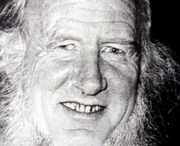
Click an Image below to Enlarge

Abstract impressionist John Anthony Tuckson (Tony) was born in 1921 at Port Said in Egypt on 24th November 1973. He was the second child of William Tuckson, a Suez Canal pilot and amateur artist, and his wife Eléonore, née Pegler. From the age of eight, Tuckson boarded and was educated in England at Gresham’s School, Holt, Norfolk and Christ’s College, Finchley, London, returning to the Canal during holidays. After studying painting for two years at the Hornsey School of Art, London, Tuckson worked in a furniture store at Kingston-upon-Thames in 1939 and attended night-classes at the Kingston School of Art.
Tuckson served as a Spitfire pilot with the Royal Air Force in the Second World War. In August 1942 he was sent to Darwin, Australia where he saw action against the Japanese. In 1943, on leave in Sydney, Tuckson married Dorothea Margaret Bisset (now Margaret Tuckson), a former design student, in Turramurra, Sydney in 1943. They had one son. Tuckson went on to become a flying instructor in Wirraway aircraft and was demobilized from the RAF with the rank of flight lieutenant on 10 August 1946 in Sydney. After the war, Tuckson settled in Australia and studied at the East Sydney Technical College, graduating in 1949.
The artist admired the work of Picasso, Matisse, Klee and Cezanne. In 1949 an exhibition in Sydney of Ronald Berndt’s collection of Aboriginal art from Arnhem Land sparked Tuckson’s lifelong passion for Aboriginal art. Ian Fairweather was the Australian artist Tuckson admired most. In 1953 The Tucksons spent their entire savings to buy a ghostly Fairweather gouache, Pattern 1952, from the artist’s first one-man show at the Macquarie Galleries.
Until 1958 Tuckson painted in the School of Paris genre: figures, heads, still lifes and interiors. He developed a lifelong admiration for Aboriginal art, which influenced his transition to abstract impressionism. Tuckson was acknowledged as one of Australia's few superlative abstract expressionists. His work has been compared favourably with that of Jackson Pollock. Tuckson painted his economically abstract works with intuition, evoking emotional responses with his painterly gestures. Drawing was a vital continuum in Tuckson’s artistic life. It allowed him the freedom to work quickly and prepare mentally before embarking on his powerful paintings. Standing back from his surface, as far away as possible, Tuckson would suddenly leap forward to paint with loaded brush, passion and vigor. Many of his 44 sketchbooks contain examples of the way in which Tuckson highlighted the conceptual and spatial shift that happens when transferring from working flat on drawings to painting on the vertical surface. Depth within paintings was created by drawing onto the painted surface.
In 1950 Tuckson was appointed assistant director of the Art Gallery of New South Wales and deputy director in 1957, a role which saw him acclaimed for his inspiration and innovation.
Tuckson painted mainly in his spare time. He began exhibiting his own paintings with the Society of Artists and the Contemporary Art Society of Australia however he exhibited only nine paintings between 1954 and 1962.
Tuckson travelled to Melville Island and Arnhem Land with surgeon and art patron, Stuart Scougall, in 1958 and 1959 on collecting expeditions for the gallery. He mounted a touring exhibition of Aboriginal bark paintings, carvings, and other work, resulting in Berndt's book Australian Aboriginal Art (1964), and the major Melanesian Art exhibition in 1966.
Tuckson did not exhibit his own paintings again until his first solo show at Watters Gallery in 1970 where he presented 64 paintings, mainly from 1958 to 1965.
In 1967-68, the architect Andrew Anderson was commissioned to upgrade and extend the run-down, nineteenth-century gallery. The Art Gallery of New South Wales, which reopened in March 1972, is considered Tuckson's great museological achievement.
Tuckson’s second solo show in 1973, which featured 22 new works, was held just six months prior to his death from cancer in November of that year.
Since his death, Tuckson’s reputation as one of the greatest artists to work in Australia has continued to grow. His studio remains much as he left it in 1973. Hanging just outside the studio is Ian Fairweather’s gouache and pinned above the storage shelves is a printed homily: HAVE YOU STEPPED BACK FROM YOUR PAINTING LATELY?
In 1976 The Association of Galleries of New South Wales held a memorial exhibition of Tuckson’s work. In 1989 Terence Maloon in Melbourne mounted an exhibition with the title Tuckson: Themes and Variation.
Several of Tony Tuckson’s paintings are on permanent display at the National Gallery of Australia.
Copyright © 2008 Art Nomad. All rights reserved. Click here to view copyright statement